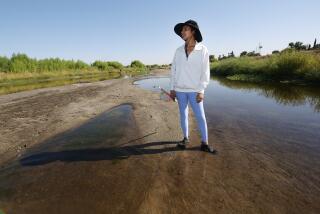Environmentalists Rap Decision on San Joaquin Water Diversion
FRESNO — A Department of Interior decision that water in the upper San Joaquin River can be diverted to farms for another 40 years without environmental review was announced Tuesday and quickly drew fire from environmentalists.
“This opinion basically gives away the store to the growers in the San Joaquin Valley,” said Hal Candee, an attorney for the Natural Resources Defense Council. Candee said the NRDC would consider legal action.
Ralph Tarr, the Interior Department’s top attorney, signed the legal opinion on Nov. 10.
“There is no discretion with respect to the quantity of water to be supplied under a renewed contract . . . therefore there is no requirement to do an environmental assessment or other impact analysis as a threshold to the renewals,” the opinion said.
Tarr, who once worked for a Fresno water law firm that has many agribusiness clients, was unavailable for comment Tuesday.
Candee said the decision “pretends there is no Clean Water Act, that the secretary of Interior is exempt from the Clean Water Act and that a (U.S. Bureau of) Reclamation contract automatically preempts all other laws. It’s completely nuts.”
Following the completion of Friant Dam near Fresno in the mid-1940s, virtually the entire flow of the river was diverted along the east side of the San Joaquin Valley to 28 irrigation districts that signed 40-year water delivery contracts.
The river diversion killed off a salmon run on the upper San Joaquin and the lower San Joaquin, between western Fresno County and the Sacramento-San Joaquin Delta, became a de facto drainage ditch for waste water from western valley farms.
The Bureau of Reclamation, the Interior Department agency that markets the Friant water, will renew those 28 contracts over the next few years and environmental groups want some of the water withheld to replenish the river’s fishery and downstream water quality.
David Houston, regional director of the Bureau of Reclamation, said that Tarr’s ruling will help stabilize the farm economy along the eastern flank of the valley.
“The best comparison would be whether or not, if it were a city, you would take the water away from the homes, the schools and industries, or whether you would go ahead and continue to stabilize the local economy,” Houston said. “The obligation of the Reclamation program is to stabilize the local economy.”
Central Valley congressmen, backed by farmers, had urged Tarr to reject any environmental study that might lead to reduced water supplies for agriculture.
‘Original Outrage’
But Candee said, “This opinion says that there’s no correcting that original outrage” of the late 1940s when the river was dried up below Friant.
“It ignores the effects on water quality, including selenium-laden drainage flows, and it ignores the bureau’s so-called new mission to restore and enhance fish and wildlife resources,” Candee said.
The NRDC attorney noted that Interior Secretary Donald P. Hodel briefly cut off water supplies to 42,000 acres in the Westlands Water District in 1985 when selenium-tainted drainage triggered an environmental disaster at the Kesterson Reservoir. But Houston said the contracts for the eastern valley irrigation districts did not include the same environmental safeguards as the Westlands contract.
An Oct. 19 letter to Tarr from Environmental Protection Agency officials urged a full environmental impact study of the contract renewals. “This is particularly appropriate since recent advances in irrigation technology and conservation may allow farmers to use considerably less water per acre than when contracts were originally signed,” the EPA letter stated.
More to Read
Sign up for Essential California
The most important California stories and recommendations in your inbox every morning.
You may occasionally receive promotional content from the Los Angeles Times.









